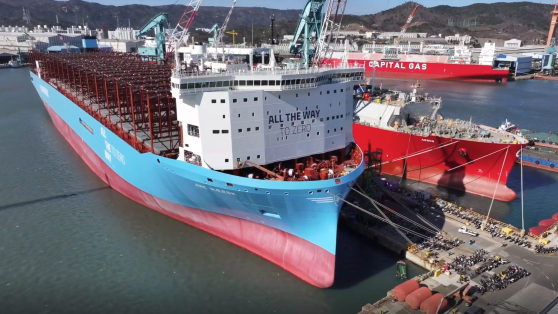
The television program 21 Sunday focused on the production of green fuels for shipping in the edition broadcasted on DR on 11 February. Energy Modeling Lab has made the calculations on which DR bases the main point of the broadcast: It is a huge challenge to build up the production of green fuels and establish the supply lines for green shipping.
DR used Ane Mærsk as an example. It is a brand-new container ship that can sail on green methanol. To make enough green methanol for Ane Mærsk to sail for a year, electricity must be used from a solar park the size of the one in Kassø in Southern Jutland. This is what our calculations show. The solar park in Kassø is the largest in Northern Europe.
Maersk’s goal is that 25 percent of the company’s fleet must sail on green fuels in 2030. If it sails on green methanol, and the power is to be supplied from solar parks in Denmark, it will require approximately 120 parks of the same size as Kassø.
We have used the Danish Energy Agency’s technology catalog as the basis for our calculations. The catalog shows how much power different technologies can be assumed to produce calculated on average.
All our calculations
All our calculations can be studied closely in the Excel sheet
Calculations-of-Area-Use-for-Green-Fuels-for-Shipping-1
We have calculated the needed area use for six different types of green fuel production:
- First generation biofuel
- Second generation biofuel
- A mixture of first- and second-generation biofuel
- Solar plants in Denmark
- Solar plants in Morocco
- Wind farms in the North Sea
We show the needed area use as percentages of the following areas:
Denmark, Falster, Langeland, Horns Rev3, Morocco, Denmark’s agricultural area, Bhadla Solar Park (one of the world’s largest solar parks located in India), the Amazon, and soccer fields.
We have calculated the needed area use to produce green fuel for Ane Mærsk, 25 percent of Maersk’s fleet, 100 percent of Maersk’s fleet, and 100 percent of international shipping.
Solar parks in Morocco
We do not expect large-scale production of green methanol on solar energy will be built up in Denmark. Solar parks are more efficient further south. Therefore, we have also calculated how large an area would be required if solar parks were to be built in Morocco: In Morocco, a 254-hectare solar park would be needed to produce enough electricity for Ane Mærsk. The facility in Kassø occupies 326 hectares.
To supply 25 percent of Mærsk’s fleet with green methanol, the size of the needed solar parks if built in Morocco, corresponds to 60 percent of Falster’s area. It is Maersk’s goal that the company’s entire fleet sail on green fuels by 2040. This will require solar parks in an area equivalent to two and a half times Falster’s (247 percent) if they are indeed built in Morocco.
If we take the area of one of the world’s largest solar parks, namely Bhadla Solar Park in India, Maersk will need the production of electricity from 22 parks of Bhadla’s size. Bhadla Solar Park covers an area of 5700 hectares.
If all international shipping is to sail on green methanol, electricity equivalent to the output of almost 740 solar parks of Bhadla’s size must be produced.
Supply from offshore wind turbines
If all international shipping is to sail on green methanol, it will require as much power as approximately 3290 offshore wind farms can produce. This calculation assumes that the offshore wind farm has the same size and performance as Horns Rev3 in the North Sea. We have chosen to use Horns Rev3 in the North Sea as an example because it is one of the world’s most efficient wind farms.
Green methanol from biofuels
Until now, green fuels have primarily been produced from plants such as corn, soybeans, and rapeseed. It is called first-generation biofuel. Maersk opts out of using that type of fuel. If all international shipping were to sail on first-generation biofuel produced from soybeans, an area the size of more than half of the Amazon would have to be harvested every year.
It is also possible to use residual products such as soy straw to make biofuel. It is referred to as second-generation biofuel.
If Maersk’s entire fleet were to sail on second-generation biofuel produced from soy straw, an area equivalent to more than twice the area of Denmark would have to be harvested every year. If the entire world’s fleet were to sail on this type of biofuel, an area equivalent to almost 74 times the area of Denmark would have to be harvested.
Related videos and articles on DR’s website
Nu kommer Mærsks grønnere skibe sejlende
Søfarten omstiller sig i sneglefart
Video explainer: Så meget plads kræver fremtidens grønne skibe
Our calculations
Calculations-of-Area-Use-for-Green-Fuels-for-Shipping-2
Duration: February 2024
EML team: Kenneth Karlsson and Ida Græsted Jensen
